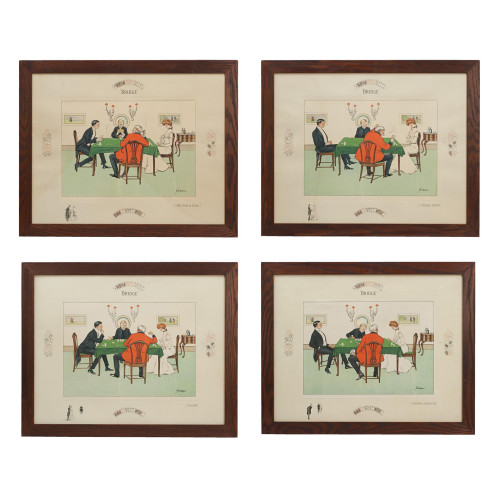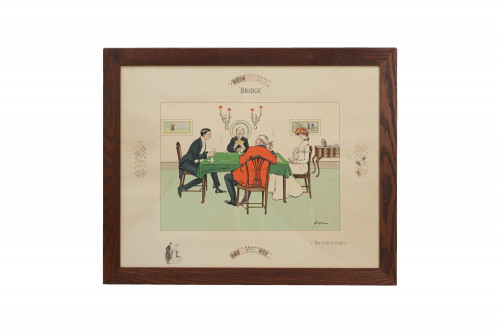- Home
- Equestrian
- Fox Hunting
- Portrat Painting Of a Hound, Belvoir Dexter.
Portrat Painting Of a Hound, Belvoir Dexter.
Portrat Painting Of a Hound, Belvoir Dexter.
29030
Belvoir Hunt Hound, Belvoir Dexter By Cuthbert Bradley.
A fine original oil painting of a Belvoir hunt hound 'Belvoir Dexter' by British artist Cuthbert Bradley (1861-1943). This is a wonderful oil painting on paper laid on board, signed and dated by the artist (lower left) with inscription. We believe 'Belvoir Dexter' was one of the Duke of Rutland's hounds as we have had a previous picture of one of his hounds, Belvoir Gambler, painted by Basil Nightingale. In 1884 when Belvoir Gambler was a five-season hunter Mr Basil Nightengale and Frank Gillard (the famous huntsman of the Belvoir pack) took some measurements of him for a painting.
Cuthbert Bradley's picture of 'Belvoir Dexter' is dated 1895 so Dexter must be from the same kennel, maybe even related.
Cuthbert Bradley was a sporting artist, journalist, author and illustrator and an extremely talented portrayer of hounds. He became a close friend of Frank Gillard and hunted for many seasons with the Belvoir Hunt. Through this friendship Bradley was able to use many hounds from this famous pack as models.
Extracts from THE HISTORY OF THE BELVOIR HUNT BY T. F. DALE.
When the fifth Duke of Rutland died in 1857, the sixth Duke took the hounds, and, with Cooper and Gillard as his huntsmen, showed good sport. This Duke was a very keen man to hounds, and so desperately hard a rider that he probably shortened his hunting career by the severity of the falls he had. The effects of these and the gout, eventually drove this keenest sportsman of all the Dukes from the hunting field. From that time to the present the interest of the history centres in the kennel, and in the names of Furrier, Rallywood, Stainless, Fallible, Weathergage, Gambler, Nominal and Dexter. In Weathergage the working qualities of the foxhound reached their highest point in our time. For work and in staying power and tongue, his son Gambler could not and did not surpass him, but in perfection of symmetry it is certain that he did, for Gambler takes the eye as almost the most perfect foxhound of our own or any other day. I should give him the honour without any reservation had I not seen Dexter, a present occupant of the Belvoir benches.
The history of the Belvoir Hunt is the story of the rise of fox-hunting in England.
An extract from the Field of March 31, 1866, is evidence of the premier position the Belvoir has maintained during the past sixty years, "perhaps the finest pack on the face of the earth, and as true as though they were run in the same mould. They are a palpable proof of what can be effected by careful selection and the scientific crossing of high families. The following are some of the fashionable sires of modern times. The Duke of Rutland's Guider and Comus; the Duke of Beaufort's Voyager and Trojan; Lord Poltemore's Archer, Warrior, Bertram, and Voyager; Lord Macclesfield's Mulciker; Lord Fitzhardinge's Lusty; Lord Portsmouth's Lincoln and Bertram.". Nearly all the most sought after foxhound sires of modern times trace to Belvoir Weathergage, pronounced by Frank Gillard "the best foxhound he ever saw in every part of a hunt." Such names occur, as Belvoir Dexter, Stormer, Handel, Vaulter, and Royal; Grafton Whynot, Woodman, and Waggoner; Lord Middleton's Dexter; Badminton Dexter; Atherstone Straggler and Streamer; Fitzwilliam Harper; Warwickshire Traveller; Cricklude Worcester and Bandit; Southwold Valiant; Cirencester Weathergage. The most successful hound-breeders have formed entire packs of such blood relationship, crossed in and out. Bone and muscle has been consolidated, but the type and character has remained fixed, the modern foxhound being a triumph of breeding and selection. The sires in office which Tom Bishopp has shown on these occasions, include many celebrities of the stud, and when showing Dexter, 1902, a son of Belvoir Dexter, 1895, it was plain to see he regarded him in the light of "a huntsman's friend," an extra-ordinary good dog in his work. Quite a Belvoir sort, he was not so handsome as his sire, though he showed a strong family likeness, especialty in the brainy appearance of the head, but he lacked the arms and stuff.
Dimensions:
1850-1899
1895
Oil
United Kingdom
Cuthbert Bradley, 95
Original oil in good condition. Some crackling to small parts of the paint.
Thank you for your enquiry.
We will get back to you soon.
Please create wishlist to add this item to
RELATED ITEMS































